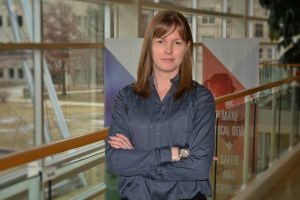Kaitlin Bratlie is an associate professor in the Departments of Materials Science and Engineering and Chemical and Biological Engineering. She has been a biomaterial researcher and professor at Iowa State since 2011.

Bratlie earned her bachelor’s degree in chemistry from the University of Minnesota and doctorate in Physical Chemistry from the University of California Berkeley in 2003 and 2007, respectively. She completed a post doctorate research experience at the Massachusetts Institute of Technology (MIT). Upon completion at MIT, she joined the faculty at Iowa State University.
Bratlie’s research is focused on two areas of biomaterials: targeting macrophages to deliver drugs to cancerous tumors to selectively kill pro-tumor cells and developing biomaterials to regenerate healthy tissue so there is less scaring and more functionality in wound healing.
Bratlie said her research is challenging because of the open-ended, unpredictable biology, but she enjoys her research because it can have an impact on someone’s life.
Targeting White Blood Cells
Much of Bratlie’s research includes targeting macrophages, a white blood cell. These cells are non-specific. This means they fight off any type of injury or infection. Any time a person develops an injury or infection, the macrophages will respond to it in two phases. At first response, macrophages are pro-inflammatory. They release a large amount of molecules to kill off the bacteria. After their initial response, the macrophages become pro-wound healing. They secrete more molecules to create new tissue growth, a healthy and positive response for our bodies.
When the human body has cancer, this healing response system of macrophages becomes a problem. Often times, tumors can be largely comprised of macrophages which are non-cancerous cells. The problem with macrophages in a cancerous tumor is the fact that they make the tumor environment permissive for the tumor growth. As pro-wound healing cells, macrophages make new tissue. In this tumorous environment, the new tissue they create are blood vessels. These new blood vessels allow nutrients to feed the tumor and create a way for the tumor to metastasize outwards. The more tumors in a person’s body with associated macrophages, the worse the prognosis.
In Bratlie’s lab, her goal is to deliver drugs to the tumor that would selectively kill the pro-tumor macrophages. The problematic twist in this biology arises because the early macrophages that come to the tumor site are anti-tumor. These macrophages secrete a lot of molecules that kill the tumor. Bratlie wants to keep those intact, but wants to kill the macrophages that are allowing the tumor to survive.
Regenerating healthy tissue through biomaterials
Another focus area of Bratlie’s research looks at biomaterials that regenerate native healthy tissue. Why is this important? If there is an implanted biomaterial, such as a bandage for a large injury, the goal is to produce less scaring and encourage more native tissue to form around the implanted biomaterial. Bratlie is working to transform the fibroblasts – cells that create collagen to develop tissue – to make collagen that resembles a human’s native tissue.
When there is an injury and tissue is damaged, a scar is typically formed. It’s easy to see the difference between a scar and the native tissue. The reason the collagen looks different is due to the organization of the new collagen. For example, in younger skin, the collagen looks like a bowl of cooked spaghetti. It’s very disorganized. Scar tissue, on the other hand, is very aligned. This alignment allows for less mechanical properties.
For most of us, this is not a common problem. However, it becomes problematic when a wound covers an elbow or part of a face, for example. This tight alignment of scar tissue can constrict the area, and it makes functioning difficult to move the elbow or close a jaw. The lack of mobility can be uncomfortable, to say the least.
Bratlie’s research in biomaterials to regenerate healthy tissue is focused on uncovering a solution for better aesthetics and functionality in wound healing.
“The whole sum of my research is to get the body to do what we want it to do around these implanted biomaterials,” said Bratlie.
Guiding the next generation of biomaterials research
Since starting her career at Iowa State, Bratlie has taught numerous materials and biomedical engineering courses.
“The interesting thing about teaching is that sometimes you get ideas for research based off of your teaching experience because you have to go back and explain the basics to undergraduate students. Students always have really good questions to ask. They always come up with something that you weren’t thinking about,” said Bratlie.
Her advice to students studying science, technology, engineering, or math was simple.
She said, “Keep at it. There are so many jobs out there. It’s a really good area to be in because there’s a lot of flexibility. If you go into industry, there’s still many different channels that are available whether you want to stay in the research and development area, gain more applied skills, or climb up the corporate ladder. There’s also an option to pursue consulting and public policy. The opportunities are endless.”
